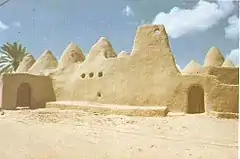Atiq Mosque, Awjila
The Atiq Mosque[lower-alpha 1] (also called the Great Mosque, or al-Kabir mosque) (Arabic: عتیق مسجد) is a mosque in the oasis village of Awjila, in the Sahara desert of the Cyrenaica region of eastern Libya. The community dates back to classical times. Since being taken by the Arabs in the seventh century, Islam has always played a central role in the life of Awjila. The 12th-century mosque, the oldest in the region, has unusual conical domes made of mudbrick and limestone that provide light and ventilation.
| Atiq Mosque | |
|---|---|
عتیق مسجد | |
 Exterior of the mosque c. 1984 | |
| Religion | |
| Affiliation | Islam |
| Branch/tradition | Sunni Islam |
| Location | |
| Location | Awjila, Libya |
 Shown within Libya | |
| Geographic coordinates | 29.127464°N 21.291016°E |
| Architecture | |
| Type | Mosque |
| Date established | 12th century |
| Materials | Mud brick and limestone |
Location
Awjila and the adjoining oasis of Jalu are isolated, the only towns on the desert highway between Ajdabiya, 250 kilometres (160 mi) to the northwest, and Kufra, 625 kilometres (388 mi) to the southeast.[1] The oasis produces high quality dates.[2] The people of the oasis are mainly Berber, and some still speak a Berber-origin language.[3] As of 2005 the Awjila language was highly endangered.[4] The mosque is located in the old city area of Awjila.[1]
History
The Arabs launched a campaign against the Byzantine Empire soon after Muhammad died in 632, quickly conquering Syria, Persia and Egypt. After occupying Alexandria in 643, they swept along the Mediterranean coast of Africa, taking Cyrenaica in 644, Tripolitania in 646 and Fezzan in 663.[5] The region around Awjila was conquered by Sidi 'Abdullāh ibn Sa'ad ibn Abī as-Sarḥ.[2] His tomb was established in Awjila around 650.[6][lower-alpha 2]
_-_The_Mosque_of_Atiq.jpg.webp)
After being introduced in the seventh century, Islam has always been a major influence on the life of the oasis. The Arab chronicler Al-Bakri says that there were already several mosques around the oasis by the 11th century.[7] Starting in the 1960s, the oil industry drove growth in the once-sleepy village.[8] By 1968, the population of the village had increased to about 2,000 people, and by 1982 it had risen to over 4,000, supported by twelve mosques.[9]
Structure
The Great Mosque of Atiq is the oldest mosque in the region.[10] The present building dates to the 12th century.[11] It was restored in the 1980s.[1] The oasis was a destination for viewing the Solar eclipse of 29 March 2006, and the mosque was again refurbished in preparation for the visitors.[12]
There is a palm tree post on each side of the entrance gate to the mosque enclosure.[12] The unusual mud brick building covers an area of 400 square metres (4,300 sq ft) and is roofed by 21 conical domes made of mud brick and limestone. Each dome has small openings so that light can enter the building.[1] The domes also serve to keep the interior cool, providing a form of natural air conditioning.[10]
The walls are 40 centimetres (16 in) thick. Nine doors lead into the interior of the building, where the many pillars and arches create a spacious, light, cool and calm environment.[1] Beside the mihrab there is a recessed niche for the minbar, where the prayer leader stands. Mosques in Arabia and East Africa have similar minbar niches, which may indicate that the mosque builders followed the Ibadi school of Islam.[11]
See also
References
Notes
- The name "Atiq Mosque" means "Old mosque".
- A modern structure has since replaced Abdullah ibn Saad's original tomb.[1]
Citations
- Ham 2007, p. 132.
- Awjila: Libyan Tourism.
- Chandra 1986, p. 113.
- Batibo 2005, p. 77.
- Falola, Morgan & Oyeniyi 2012, p. 14.
- Mason 1974, p. 396.
- Mason 1974, p. 395.
- Mason 1982, p. 323.
- Mason 1982, p. 322.
- Awjila: MVM Travel.
- Petersen 2002, p. 166.
- Atiq Mosque: Atlas Obscura.
Sources
- "Atiq Mosque: Early Islamic mosque with several strange conical domes". Atlasobscura.com. Retrieved 9 March 2013.
- "Awjila". Libyan Tourism Directory. Archived from the original on 11 April 2013. Retrieved 7 March 2013.
- "Awjila". MVM Travel. Retrieved 24 March 2012.
- Batibo, Herman (2005). Language Decline And Death in Africa: Causes, Consequences And Challenges. Multilingual Matters. ISBN 978-1-85359-808-1. Retrieved 24 March 2013.CS1 maint: ref=harv (link)
- Chandra, Satish (1986). International Protection of Minorities. Mittal Publications. GGKEY:L2U7JG58SWT. Retrieved 24 March 2013.CS1 maint: ref=harv (link)
- Falola, Toyin; Morgan, Jason; Oyeniyi, Bukola Adeyemi (2012). Culture and Customs of Libya. ABC-CLIO. ISBN 978-0-313-37859-1. Retrieved 24 March 2013.CS1 maint: ref=harv (link)
- Ham, Anthony (1 August 2007). Libya. Ediz. Inglese. Lonely Planet. p. 132. ISBN 978-1-74059-493-6. Retrieved 9 March 2013.CS1 maint: ref=harv (link)
- Mason, John Paul (October 1974). "Saharan Saints: Sacred Symbols or Empty Forms?". Anthropological Quarterly. The George Washington University Institute for Ethnographic Research. 47 (4). JSTOR 3316606.CS1 maint: ref=harv (link)
- Mason, John P. (Summer 1982). "Qadhdhafi's "Revolution" and Change in a Libyan Oasis Community". Middle East Journal. Middle East Institute. 36 (3). JSTOR 4326424.CS1 maint: ref=harv (link)
- Petersen, Andrew (11 March 2002). Dictionary of Islamic Architecture. Taylor & Francis. ISBN 978-0-203-20387-3. Retrieved 24 March 2013.CS1 maint: ref=harv (link)
| Wikimedia Commons has media related to Atiq Mosque in Awjila. |